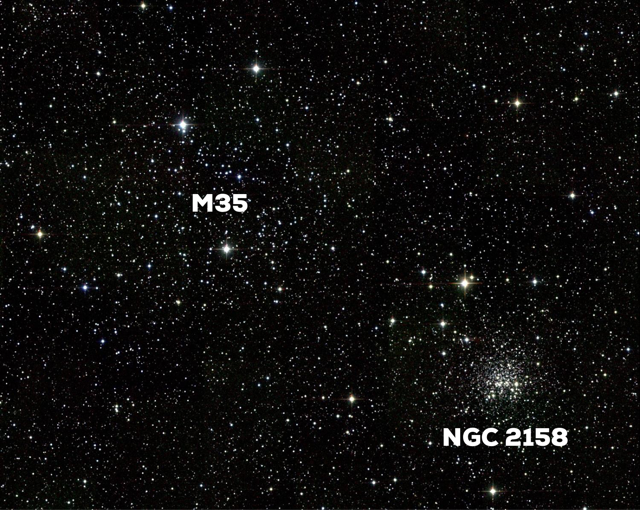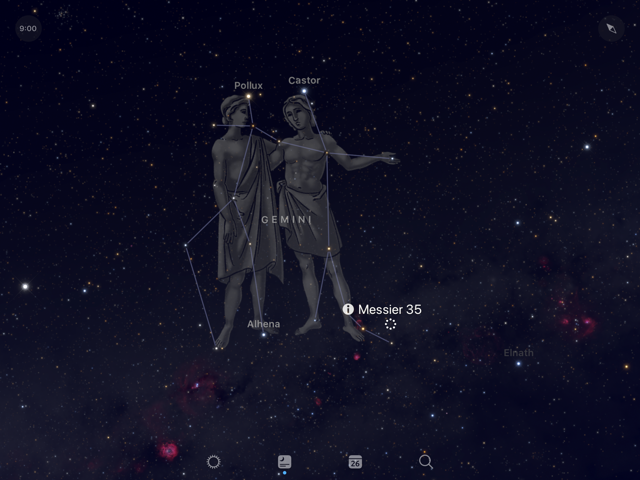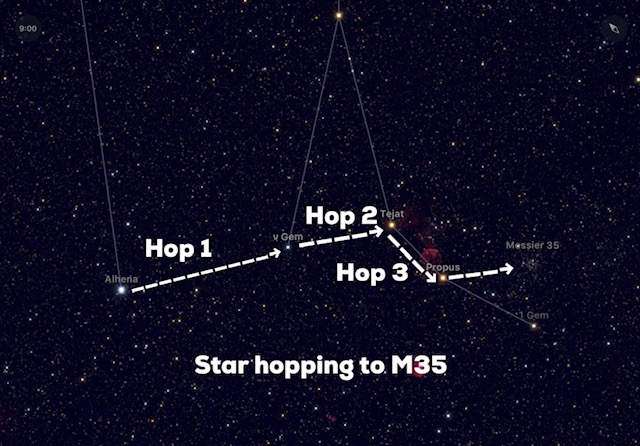 “M35 is an excellent object for any small telescope; while particularly effective with a 6 or 8-inch glass with low power, something of its beauty can be appreciated in even a 2-inch instrument. Curving rows of bright stars give an impression of rows of glittering lamps on a chain; fainter stars form a sparkling background with an orange star near the center.”- Burnham’s Celestial Handbook, An Observers Guide to the Universe Beyond the Solar System, Volume II, by Robert Burnham, Jr., 1966.
“M35 is an excellent object for any small telescope; while particularly effective with a 6 or 8-inch glass with low power, something of its beauty can be appreciated in even a 2-inch instrument. Curving rows of bright stars give an impression of rows of glittering lamps on a chain; fainter stars form a sparkling background with an orange star near the center.”- Burnham’s Celestial Handbook, An Observers Guide to the Universe Beyond the Solar System, Volume II, by Robert Burnham, Jr., 1966.
M35 is a good example of what’s known as an “open star cluster”, a loose configuration of stars that were all born from within the same stellar nursery, and which are all gravitationally bound to one another. You are probably already familiar with other examples from this category of deep sky object; things like the Pleiades star cluster (Messier 45) and the Hyades cluster (Melotte 25 or Collinder 50), both in the constellation of Taurus, or maybe even the Beehive cluster (Messier 44) in the constellation of Cancer. Those three perhaps receive more attention from budding backyard astronomers, but I would argue that M35 is always well worth a visit in its own right, no matter your level of expertise.
HOW TO FIND IT
One of the great things about M35 is that it’s visible to the unaided eye from a good dark sky locale on moonless nights and, during late winter and early spring, it is practically overhead during the early evening hours, making it well placed for easy observation.
To find it this month, go outside on any cloudless night with no moon at around 9:00 PM and look up.
Next, locate the twin stars Castor and Pollux in the constellation of Gemini. During the month of March, they are almost directly overhead by around 9pm and look like two eyes, staring back down at you. You really can’t miss them as they are among the brightest of our winter and spring stars. Castor is the one on the “right” (west) while Pollux is on the “left” (east). Visually, Pollux is brighter than Castor. From here, it’s easier if you imagine these stars as representing the heads of two stick figure-men: Pollux is on the left (east) and Castor is on the right (west). Marking the SW foot of Pollux is the third brightest star in the constellation of Gemini, Alhena. If it’s any help, Betelgeuse, in Orion, is just a little further below (south of) Alhena.
Now we are going to hop to three dim, nearby stars in a westerly direction from Alhena. From Alhena, hop to V Geminorum (Nu Geminorum). From V Geminorum, hop over to Tejat. From Tejat, we are going to go about the same distance between the last two stars, downwards (in a SW direction) to Propus. If your skies are good and dark, you will not need any visual aid in picking these three stars out.
 Now, for our final hop, I want you to extend an imaginary line towards the west from Propus. This line will be equivalent in length as the hop that you took from Tejat to Propus. At this point, you should be right on top of M35. With clear, dark skies, you can even see it as a fuzzy patch of light, almost the same size as the full moon.
Now, for our final hop, I want you to extend an imaginary line towards the west from Propus. This line will be equivalent in length as the hop that you took from Tejat to Propus. At this point, you should be right on top of M35. With clear, dark skies, you can even see it as a fuzzy patch of light, almost the same size as the full moon.
WHAT YOU ARE SEEING
Even with a modest amount of optical aid, this faint, fuzzy patch of light upon the sky, seemingly devoid of any stars, will reveal itself as a dense and glittering array of starry goodness. Through binoculars you should see about a half dozen or so of its brightest members, all set against the combined glow of stars that are too faint to be seen individually. Larger aperture telescopes will reveal more and more individual stars across your entire FOV, in addition to those half dozen brightest members. With 6” aperture or more telescopes, you should also be able to see that some of these stars are arranged as short, shimmering strands of stars, almost like strands of Christmas tree lights. Most of the individual stars that you see are main sequence (still fusing hydrogen within their cores), blue-white giants while some, being more evolved (having mostly depleted their core’s hydrogen supply), will show hints of orange and yellow. Because M35 is so large upon the sky, being almost the same size as the full moon, you should always use low magnifications in order to see it at its best. Higher magnifications will only decrease your FOV and you will not be able to see the cluster in its full glory.
 Messier 35 was first discovered in either 1745 or 1746 by Swiss astronomer Jean-Philippe Loys de Chéseaux (English astronomer John Blevins is also usually credited with having independently discovered this star cluster at some point before the year 1750) and was finally included in Charles Messier’s famous catalog of “not comet objects” in the year 1764.
Messier 35 was first discovered in either 1745 or 1746 by Swiss astronomer Jean-Philippe Loys de Chéseaux (English astronomer John Blevins is also usually credited with having independently discovered this star cluster at some point before the year 1750) and was finally included in Charles Messier’s famous catalog of “not comet objects” in the year 1764.
 M35 is located some 2,800 light years away and has an estimated age of around 110 million years, very young as far as stars go. There are at least 500 member stars within M35 and, together, the cluster spans some 22 light years across. As a bonus, if you look just to the SW of M35, you will see an even more distant open star cluster known as NGC 2158. This cluster is unrelated to M35, is far more compact, and is much older with an estimated age of 1 billion years. NGC 2158 is 16,000 light years away, much more distant than M35. Both clusters are situated within the plane of our Milky Way Galaxy. Which makes sense as it is within the plane of the galaxy that you happen to find the greatest concentrations of gas and dust (the stuff that goes into the making of stars) as well as the greatest concentrations of stars themselves.
M35 is located some 2,800 light years away and has an estimated age of around 110 million years, very young as far as stars go. There are at least 500 member stars within M35 and, together, the cluster spans some 22 light years across. As a bonus, if you look just to the SW of M35, you will see an even more distant open star cluster known as NGC 2158. This cluster is unrelated to M35, is far more compact, and is much older with an estimated age of 1 billion years. NGC 2158 is 16,000 light years away, much more distant than M35. Both clusters are situated within the plane of our Milky Way Galaxy. Which makes sense as it is within the plane of the galaxy that you happen to find the greatest concentrations of gas and dust (the stuff that goes into the making of stars) as well as the greatest concentrations of stars themselves.
No matter the aperture of your optical equipment, M35 is going to be a lovely sight and all it takes to observe it is some clear, dark skies and the will to get outside in order to look up in both awe and wonder.